 |
|
|
“What dreadful hot weather we have.
It keeps me in a continual state of inelegance.” |
|
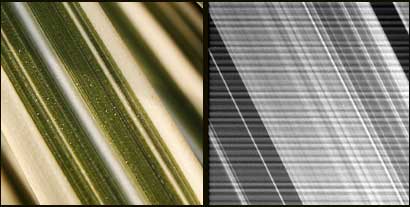 Variegated cattails thrive in the reflecting ponds outside the Linnean greenhouse. In the beds alongside are ample clumps of Variegated Eulalia (Miscanthus sinensis). Both plants have striped, arching leaves that end as a point. I got as close as I could to the Eulalia leaves. Up close, from just the right angle, the washed-green and creamy-white stripes of the draping fans look much like the pictures of the rings of Saturn that the Cassini probe sent to earth as it passed though the planet's rings. Next weekend, the botanical garden will have its annual daylily sale. This week we got a preview of some of the plants slated for the sale. During the week, a throng of volunteers will meet at the daylily garden to dig, separate, and label all the plants with sheered fans. If the digging happens as I have seen it happen before, the marked plants will be dug and the largest three or four fans will be replanted. Excess fans then will go to the sale. For diehard daylily devotees who know the significance of sheered and unsheered plants, today is the perfect day to make a list of must-have plants. Others, who don't know or care about daylilies, must wonder why the daylily garden is a patchwork of cut and uncut plants. 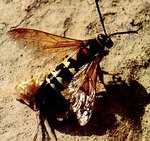 A sign near a line of caution tape that blocks the entrance to the herb garden says "Cicada-killer wasps have temporarily taken over the herb garden." We saw some wasps sunning themselves on a stucco wall. Squads of them also were making low-level passes over the beds of basil and rosemary. The wasps are big: as long as adult's thumb. They look and act menacing, but they rarely sting. The male can't sting. The female can, but won't unless it somehow gets pinned against a person's skin. A sign near a line of caution tape that blocks the entrance to the herb garden says "Cicada-killer wasps have temporarily taken over the herb garden." We saw some wasps sunning themselves on a stucco wall. Squads of them also were making low-level passes over the beds of basil and rosemary. The wasps are big: as long as adult's thumb. They look and act menacing, but they rarely sting. The male can't sting. The female can, but won't unless it somehow gets pinned against a person's skin.According to the sign, the female wasp digs a long tunnel-like burrow in the soil. Then it flies off to find a cicada. When it does, it paralyzes the cicada with a sting and takes the immobilized cicada back to the burrow. Then the wasp lays an egg on the cicada and seals the cicada and egg in a compartment. So it goes until the tunnel is filled with nine or ten chambers of cicadas and wasp eggs. "A cicada killer dragging a large immobilized cicada over the ground to its nest is an impressive natural event" says an article written for the Missouri Department of Conservation. Unless I cross the caution tape though, it's a sight I'm not likely to see. 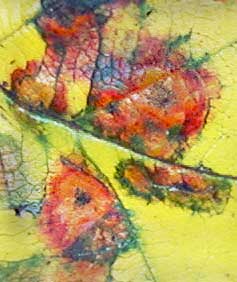 Cedar-apple rust has infected a swath of crabapple trees on the east side of the Japanese Garden. The leaves have turned bright yellow. Their surfaces are covered with dozens of small shapes that look murky cells. Circles of oranges, rusts, greens, and browns surround their dried-blood colored centers. The most colorful leaves are the ones that have already fallen. The keepers of the Garden probably quickly see past the beauty of the shapes and color of the leaves. Likely they think more about whether the trees weakened by losing their leaves before they ought to can withstand the winter. Cedar-apple rust has infected a swath of crabapple trees on the east side of the Japanese Garden. The leaves have turned bright yellow. Their surfaces are covered with dozens of small shapes that look murky cells. Circles of oranges, rusts, greens, and browns surround their dried-blood colored centers. The most colorful leaves are the ones that have already fallen. The keepers of the Garden probably quickly see past the beauty of the shapes and color of the leaves. Likely they think more about whether the trees weakened by losing their leaves before they ought to can withstand the winter.Last week the water level of the lake in the Japanese Garden was down a foot or more. This week it floods its banks. The lake has circulation problems. Since the equipment is still here, the problems have not been fixed yet. Until they are, the lake will rise and fall with the weather, not with pumps and regulators. 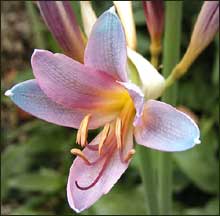 They have arrived earlier this year. The resurrection lilies (Lycoris squamigera) have hastily put up stocks and have begun to bloom. In other years, I've happen upon them when they were in full bloom. Then their petals were scrolled open and they were an expensive-cosmetic shade of pink. This early morning I saw the lilies just after they opened. The young lilies glow from their centers and then give way to deep pinks and wispy blues. They have arrived earlier this year. The resurrection lilies (Lycoris squamigera) have hastily put up stocks and have begun to bloom. In other years, I've happen upon them when they were in full bloom. Then their petals were scrolled open and they were an expensive-cosmetic shade of pink. This early morning I saw the lilies just after they opened. The young lilies glow from their centers and then give way to deep pinks and wispy blues.I've looked at too many pictures of daylilies on too many web pages. I noticed that both those who sell them and who buy them like to pump up the color in the pictures they show off. In taking my own pictures, I find that sometimes my digital camera and my eyes don't agree on what color a daylily actually is.  Because I have the last word on the matter, I try to bring the camera's image more in line with what I think I saw. This morning though I saw two late-season daylilies whose colors the camera and I could agreed upon. One of them, 'Susan Weber,' could have slipped unnoticed into a colony of resurrection lilies. The other flower had orange-red petals with vein-like tracings. The developer, who surely didn't give much thought to marketing possibilities, called it 'Blood Flow.' It's too late to add these two beauties to the list of my dozen favorites for this year, but as late-season attention-getters, these two are standouts. This part of the Midwest is outside the cicada belt where billions of the insects emerged this summer. Here, instead of the hoards that appeared on the East Coast, we have what are called the annual or "dog-day cicadas" because they usually begin emerging in late July. I saw the hull of one of these dog-day cicadas fastened to the knobby bark of the enormous Armur Cork tree growing just north of the daylily garden. I've seen these empty brown shells before, but not in the Garden. But aside from thinking how odd they look, I'd never given them much thought. 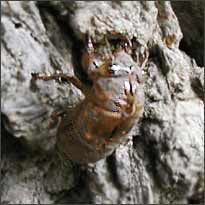 It turns out the shell I saw belonged to a cicada nymph that lived underground while feasting on the sap of the small roots of the Amur Cork tree. When the adult was ready to break out of the shell, the nymph climbed the tree and dropped anchor on the bark. Then the casing of the shell split open just behind the nymph's head and the adult cicada worked its way out. John Dwiggins, a North Carolina homeowner with a video camera, took a series of intriguing pictures of a cicada in his backyard as it slowly worked its way out of shell. It turns out the shell I saw belonged to a cicada nymph that lived underground while feasting on the sap of the small roots of the Amur Cork tree. When the adult was ready to break out of the shell, the nymph climbed the tree and dropped anchor on the bark. Then the casing of the shell split open just behind the nymph's head and the adult cicada worked its way out. John Dwiggins, a North Carolina homeowner with a video camera, took a series of intriguing pictures of a cicada in his backyard as it slowly worked its way out of shell.Soon after the adult emerges, the love songs begin. The male flies to a sunny tree and sings. A female that likes the tune flies over, they mate, and then the male keels over and dies. The female then lays 600 (give-or-take) eggs in a branch of a young tree and then dies too. Six to eight weeks later, the eggs hatch, the nymphs fall to the ground, and the cycle starts all over again. As I looked at the cicada hull on the tree, inspecting the slit below the head where the adult emerged, I wondered if the shell had any other use. Apparently, there is nothing that can't be sold. A company called Nature's Creations Natural Jewelry collects the casings, covers them in copper, shines then up, and markets them as broaches for $36 a pin: "The exit opening is visible on every pin."  The Japanese Garden called Seiwa-En –the Garden of pure, clear harmony and peace– was noisy and smelly this morning. At one end of the lake a loud pump was running constantly. Other than caution tape and "DANGER" sprayed on a sheet of plywood there were no signs to let visitors know what was going on or why. I did notice though that the water level in the 4.5-acre lake is down by a foot and that most of the large koi seem to be gone, so I suspect that lake is being dredged. Why is it being done? How long will it take? Where will all the water go? How long will the smell of methane linger? What has happened to the fish? No press release has been issued. The Japanese Garden called Seiwa-En –the Garden of pure, clear harmony and peace– was noisy and smelly this morning. At one end of the lake a loud pump was running constantly. Other than caution tape and "DANGER" sprayed on a sheet of plywood there were no signs to let visitors know what was going on or why. I did notice though that the water level in the 4.5-acre lake is down by a foot and that most of the large koi seem to be gone, so I suspect that lake is being dredged. Why is it being done? How long will it take? Where will all the water go? How long will the smell of methane linger? What has happened to the fish? No press release has been issued.I was startled by a tiny garter snake that poked its head up between a flat rock and a dark-colored creeper. Seeing something wild in a place where most of nature has been tamed, manicured, and finely distilled by planners and planters was refreshing. I walked through the shade garden of native plants this morning and thought back to a nature walk I took with a group led by naturalist Edgar Denison. We walked for three hours to see the handful of flowers that Dennison wanted to show us. In this botanical garden though, time and space are concentrated. Here I can see all of the wild flowers and shrubs I saw on that long nature walk and dozens more by just walking a few yards along a paved path. Sighting a new flower in a botanical garden is akin to finding an egg in an Easter egg hunt. Someone put the egg in a scarcely hidden place so that it could be found quickly and easily. I wonder if spending too much time in a botanical garden has made me impatient with the vagaries of nature outside these walls? I can't remember when I walked a real trail or visited a place where nobody labeled every living thing. 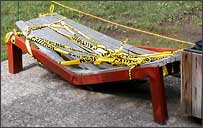 For weeks now a bench in the Japanese Garden has been cordoned off by yellow caution tape. An overhanging limb from a nearby tree snapped and landed on the bench. The sturdy bench of wood and steel now has a v-shaped slope. The ailing tree has been cut down and the limb that caused the damage has been hauled away. This morning I overheard two women talking about what might have caused the bench to buckle. Their guess was that "a too fat person must have stopped there to rest."
For weeks now a bench in the Japanese Garden has been cordoned off by yellow caution tape. An overhanging limb from a nearby tree snapped and landed on the bench. The sturdy bench of wood and steel now has a v-shaped slope. The ailing tree has been cut down and the limb that caused the damage has been hauled away. This morning I overheard two women talking about what might have caused the bench to buckle. Their guess was that "a too fat person must have stopped there to rest."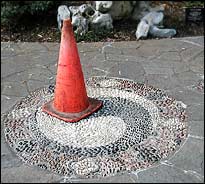 Pebble mosaics of plum blossoms, birds, and tree peonies are prominent features of the flagstone walk in the Chinese Garden. At the place where the walk divides, there is a mosaic of a yin-yang symbol. This morning for no reason that I could see, someone had put an orange danger cone at the point where yin meets yang. In a Chinese garden where everything has symbolic meaning, I wondered what I was to infer about the perfect balance of all things today.
Pebble mosaics of plum blossoms, birds, and tree peonies are prominent features of the flagstone walk in the Chinese Garden. At the place where the walk divides, there is a mosaic of a yin-yang symbol. This morning for no reason that I could see, someone had put an orange danger cone at the point where yin meets yang. In a Chinese garden where everything has symbolic meaning, I wondered what I was to infer about the perfect balance of all things today.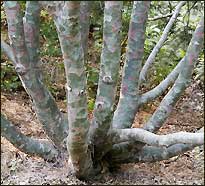 In the Chinese garden the bamboo, the pines, and flowering plum trees are the three "friends of winter" either because they stay evergreen or bloom before winter has ended. I've often looked at the bamboo and I always visit the Chinese Garden in early February to look for the first fragrant blooms of the "plum blossom." (Prumus mume). Until today though, I never noticed the third friend - the pines. I should have. There are two unusual, rare pines in the Chinese Garden: the Lacebark Pine (Pinus bungeana) and the Himalayan Pine (Pinus wallichiana). I first noticed lacebark pines at the Dawes Arboretum near Newark, Ohio. There they are behind a fence to keep lovers from carving hearts and arrows on their attractive barks. The barks of lacebark pines are mottled with random patterns of quiet burgundy, olive drab and brown much like camouflage fabric. The tree has a cluster of trunks that begin together and then spread up and out.
In the Chinese garden the bamboo, the pines, and flowering plum trees are the three "friends of winter" either because they stay evergreen or bloom before winter has ended. I've often looked at the bamboo and I always visit the Chinese Garden in early February to look for the first fragrant blooms of the "plum blossom." (Prumus mume). Until today though, I never noticed the third friend - the pines. I should have. There are two unusual, rare pines in the Chinese Garden: the Lacebark Pine (Pinus bungeana) and the Himalayan Pine (Pinus wallichiana). I first noticed lacebark pines at the Dawes Arboretum near Newark, Ohio. There they are behind a fence to keep lovers from carving hearts and arrows on their attractive barks. The barks of lacebark pines are mottled with random patterns of quiet burgundy, olive drab and brown much like camouflage fabric. The tree has a cluster of trunks that begin together and then spread up and out.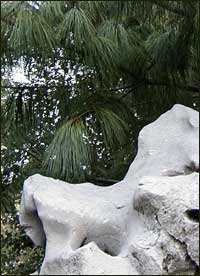 I didn't notice the bark or the trunk on the Himalayan Pine. On this tree the needles grabbed my attention. Tufts of eight-inch needles, more blue than green, dangle from the ends of every branch. They arch and droop giving the tree a shaggy yak look. The Himalayan Pine is planted just behind a Tai Hu stone as if to soften the hardness of the rock.
I didn't notice the bark or the trunk on the Himalayan Pine. On this tree the needles grabbed my attention. Tufts of eight-inch needles, more blue than green, dangle from the ends of every branch. They arch and droop giving the tree a shaggy yak look. The Himalayan Pine is planted just behind a Tai Hu stone as if to soften the hardness of the rock.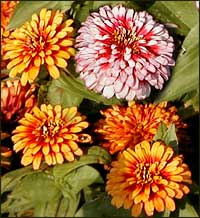 What the world doesn't need now is another variety of petunia or zinnia. Yet the demand for new varieties of these old favorites seems insatiable. Every summer the Garden sets aside a bed or two to try out the hot new varieties of the year. I usually ignore the petunias, but I'm always curious about the latest reincarnation of the zinnia. This year it's the "Swizzle" varieties: "Scarlet and Yellow" and "Cherry and Ivory." A seed catalog calls the Swizzle the "showiest zinnia to come along in years." They have all the expected traits needed for fame: they are no more than a foot tall; they are loaded with blooms; and they have colors that dazzle. More than that though, the Swizzles have a magical "how did they do that?" quality. Some petals are the lighter of the bi-colors; some the darker. Most remarkably though, some of the darker petals look as though they have had their tips dipped in a bucket of the lighter hue.
What the world doesn't need now is another variety of petunia or zinnia. Yet the demand for new varieties of these old favorites seems insatiable. Every summer the Garden sets aside a bed or two to try out the hot new varieties of the year. I usually ignore the petunias, but I'm always curious about the latest reincarnation of the zinnia. This year it's the "Swizzle" varieties: "Scarlet and Yellow" and "Cherry and Ivory." A seed catalog calls the Swizzle the "showiest zinnia to come along in years." They have all the expected traits needed for fame: they are no more than a foot tall; they are loaded with blooms; and they have colors that dazzle. More than that though, the Swizzles have a magical "how did they do that?" quality. Some petals are the lighter of the bi-colors; some the darker. Most remarkably though, some of the darker petals look as though they have had their tips dipped in a bucket of the lighter hue.I think it's interesting that the garden finds room for a bed of botanical hussies like the Swizzles, but has no space to display and label the shrubs and flowers that most of us see when we cut across fields, drive along city streets, or step across cracks in the sidewalk. Chicory, purselane, and sweet rocket seem to grow everywhere but in the botanical garden. I was pleased to see that a book that gives these outsider botanicals their due just appeared in the Garden's gift shop: The Book of Field and Roadside: Open-Country Weeds, Trees, and Wildflowers of Eastern North America by John Eastman and Amelia Hansen . Maybe a bed of real plants will follow.  The stocks of the Ornamental Millet 'Purple Majesty' must be maturing: a treat for any sparrow that can find a footing.
The stocks of the Ornamental Millet 'Purple Majesty' must be maturing: a treat for any sparrow that can find a footing.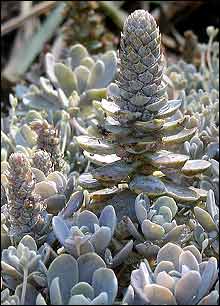 I think that if I looked back to some of the notes in my archive I would find a photo like this one. It's a photo taken close to ground level of a bluish succulent whose name I don't care to know. It's the thoughts spurred by close-up image of the plants, not the plants themselves, that grabbed my attention I think that if I looked back to some of the notes in my archive I would find a photo like this one. It's a photo taken close to ground level of a bluish succulent whose name I don't care to know. It's the thoughts spurred by close-up image of the plants, not the plants themselves, that grabbed my attentionCaladiums now fill the spaces emptied of tulips and daffodils. The keepers of the Garden don't take as much care in labeling caladiums as they do with spring bulbs. Caladiums seem to be here as placeholders to add summer color until the spring bulbs return to reclaim their rightful places. In my own garden, I also used caladiums to fill-in for some spring-blooming bleeding hearts that I knew would die back by summer. I decided to buy the bulbs I needed from a Florida grower called Caladium World. Originally, I planned to order a speckled small-leaf variety called 'Gingerland,' from them, but my wife nixed my choice as "too gaudy." She was right. The reds, greens, and whites on the 'Gingerland' leaves wouldn't stay put. The colors peppered themselves helter-skelter all over the leaf face. So instead we settled on the more orderly 'Frieda Hemple' with its all-red centers and borders of uninterrupted green. 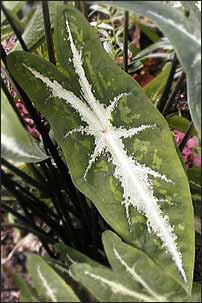 This morning though we saw a caladium that we both liked. It had a medium-sized leaf with a lance point, but was much narrower than any caladium leaf we had ever seen before. Most of the leaf has a camouflage pattern of olive shades. The ivory-colored center looks some Peruvian land drawing that only makes sense from the air. The odd caladium (if that's what it is) had no label, so I plan to send this picture to Caladium World with a promise to buy some if they will identify it for me. This morning though we saw a caladium that we both liked. It had a medium-sized leaf with a lance point, but was much narrower than any caladium leaf we had ever seen before. Most of the leaf has a camouflage pattern of olive shades. The ivory-colored center looks some Peruvian land drawing that only makes sense from the air. The odd caladium (if that's what it is) had no label, so I plan to send this picture to Caladium World with a promise to buy some if they will identify it for me.The spectacle of daylilies is less spectacular this morning. There are still plenty of flowers, but all the plants that are going to bloom have bloomed or at least started to bloom. So, it's again time to pick my Dozen Best. My choices are based on whim. I count neither buds, nor scapes, nor petals. I don't measure blossom size or the height of stocks. I don't care about how long the blooms last or whether the spent blossoms look like a glass of day-old beer. For about a month now I've been picking a couple of my favorites each week. I didn't look at the picks I made last year or at the lists of national daylily societies. I added a daylily to my 2004 list because of all the daylilies blooming on that morning, I most wanted to take a picture of it. So, here is the list and the pictures: my Dozen Favorite Daylilies of 2004. As it turns out, none of my picks were in the top dozen or even the top two dozen of the American Hemerocallis Society's most popular varieties. However, I did check the Society's lists of major award and medal winners. Five of my twelve picks took top awards: 'Bess Ross,' 'Etched Eyes,' 'Red Rum,' 'Sabine Baur,' and 'Green Flutter.' (That's not remarkable though because the Garden is loaded with medal winners.) Only one of the daylilies I picked this year was on my top dozen list of 2003: 'Acquire the Fire.' Now that my 2004 list of favorites is finished, I'm ready. With list in hand, I plan to take on the crowds who will be at the botanical garden's two big daylily sales next month to try to get some of my picks for my own garden. 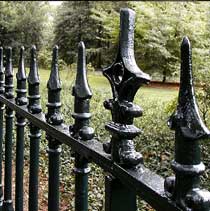 The iron fence around the grove of trees that shade the mausoleum where Henry Shaw is entombed has been removed for nearly a year. Many parts of fence and some ornate finials that topped the fence were rusted, corroded, damaged, or missing. We thought the old fence that had been protecting the mausoleum grounds for a century had been scraped and that a new look-alike fence would replace it. Today the fence was back. So was the man who brought it back. He told me that except for the rails that were rusted too badly to be saved, the fence and finials are original. Slow, careful restoration and lots of galvanizing allowed the fence to be saved. Fence and finials dressed in very formal, dark green enamel look splendid. The iron fence around the grove of trees that shade the mausoleum where Henry Shaw is entombed has been removed for nearly a year. Many parts of fence and some ornate finials that topped the fence were rusted, corroded, damaged, or missing. We thought the old fence that had been protecting the mausoleum grounds for a century had been scraped and that a new look-alike fence would replace it. Today the fence was back. So was the man who brought it back. He told me that except for the rails that were rusted too badly to be saved, the fence and finials are original. Slow, careful restoration and lots of galvanizing allowed the fence to be saved. Fence and finials dressed in very formal, dark green enamel look splendid.We took all of the plastic flats and gallon containers that we got when we bought bedding plants and perennials to the Garden's Horticultural Recycling Center. We were not the only ones to recycle. The Garden reported that in 2003 they collected 30,000 pounds of horticultural plastic and a total of 275,000 pounds since opening their collection site a few years ago. The pots are made into high-density plastic lumber that the Garden sells as 2" x 6" x 8' planks and as raised bed kits. |
|